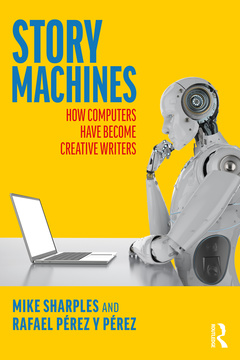Story Machines: How Computers Have Become Creative Writers How Computers Have Become Creative Writers
Auteurs : Sharples Mike, Pérez y Pérez Rafael

This fascinating book explores machines as authors of fiction, past, present, and future. For centuries, writers have dreamed of mechanical storytellers. We can now build these devices. What will be the impact on society of AI programs that generate original stories to entertain and persuade? What can we learn about human creativity from probing how they work?
In Story Machines, two pioneers of creative artificial intelligence explore the design and impact of AI story generators. The book covers three themes: language generators that compose coherent text, storyworlds with believable characters, and AI models of human storytellers. Providing examples of story machines through the ages, it covers the history, recent developments, and future implications of automated story generation.
Anyone with an interest in story writing will gain a new perspective on what it means to be a creative writer, what parts of creativity can be mechanized, and what is essentially human. Story Machines is for those who have ever wondered what makes a good story, why stories are important to us, and what the future holds for storytelling.
Preface, Chapter 1. Can a computer write a story?, Chapter 2. Human story machines, Chapter 3. Artificial versifying, Chapter 4. Automatic novel writers, Chapter 5. The shape of a story, Chapter 6. The program that swallowed the internet, Chapter 7. Storyworlds, Chapter 8. Being creative, Chapter 9. Modelling the mind of a writer, Chapter 10. Build your own story generator, Chapter 11. Capacity for empathy, Notes, Further reading
Mike Sharples is Emeritus Professor of Educational Technology at The Open University, UK. He is the author of How We Write: Writing as Creative Design. His other works include Computers and Thought: A Practical Introduction to Artificial Intelligence and over 300 books and papers on artificial intelligence, computers and writing and educational technology.
Rafael Pérez y Pérez is a full Professor at Universidad Autónoma Metropolitana at Cuajimalpa, México City. He specializes in computational creativity, particularly models for narrative generation, and has led the Association for Computational Creativity. His works include MEXICA: 20 Years – 20 Stories, Creatividad Computacional and diverse papers on artificial intelligence and computational creativity. His website is www.rafaelperezyperez.com.
Date de parution : 07-2022
15.6x23.4 cm
Date de parution : 07-2022
15.6x23.4 cm
Thèmes de Story Machines: How Computers Have Become Creative Writers :
Mots-clés :
Story Machines; Computer Program; Story Grammar; Jaguar Knight; Fairy Tales; Young Men; Main Character; AI Program; Medieval French Epics; Camelot; Follow; Wo; Kidnaps; Colossal Cave Adventure; Ars Brevis; Grand Theft Auto; Teddy Bear; Dwarf Fortress; Yoghurt Pot; Uncanny Valley; Tram; Oulipo Group; Determiner Adjective Noun; Ramon Llull; Artificial Versifying



